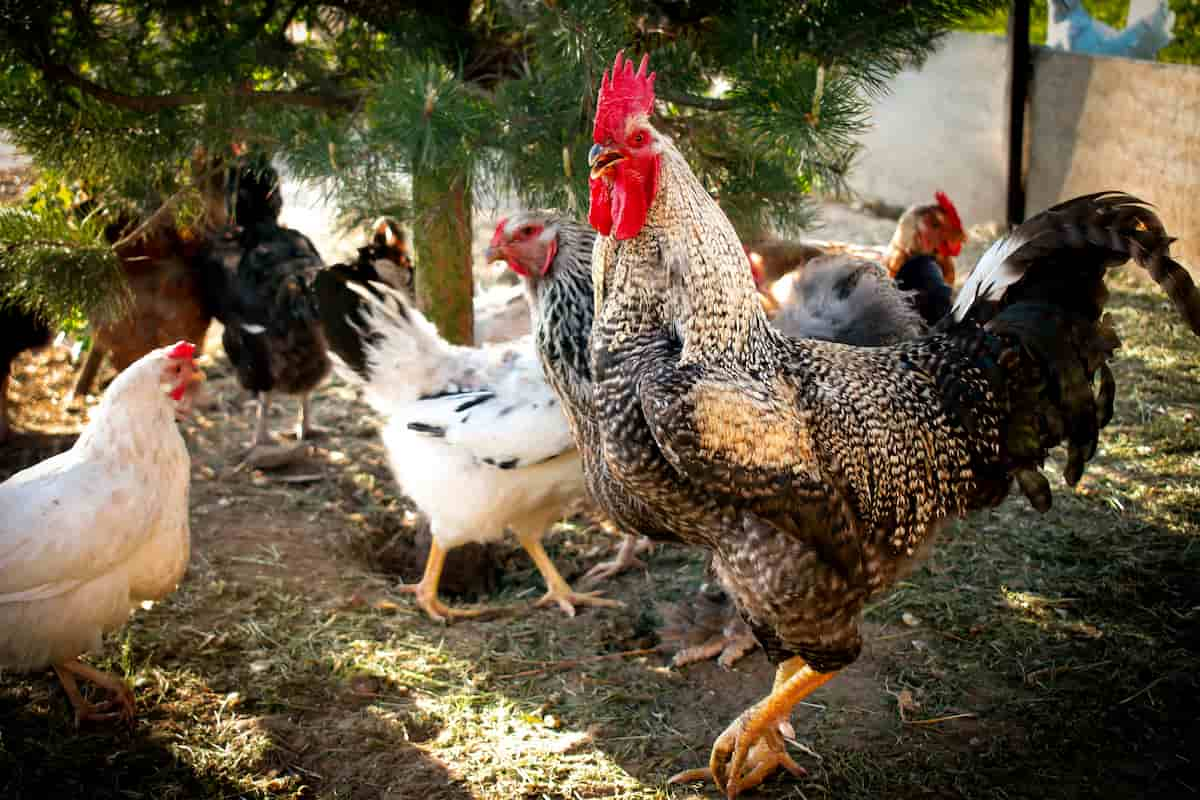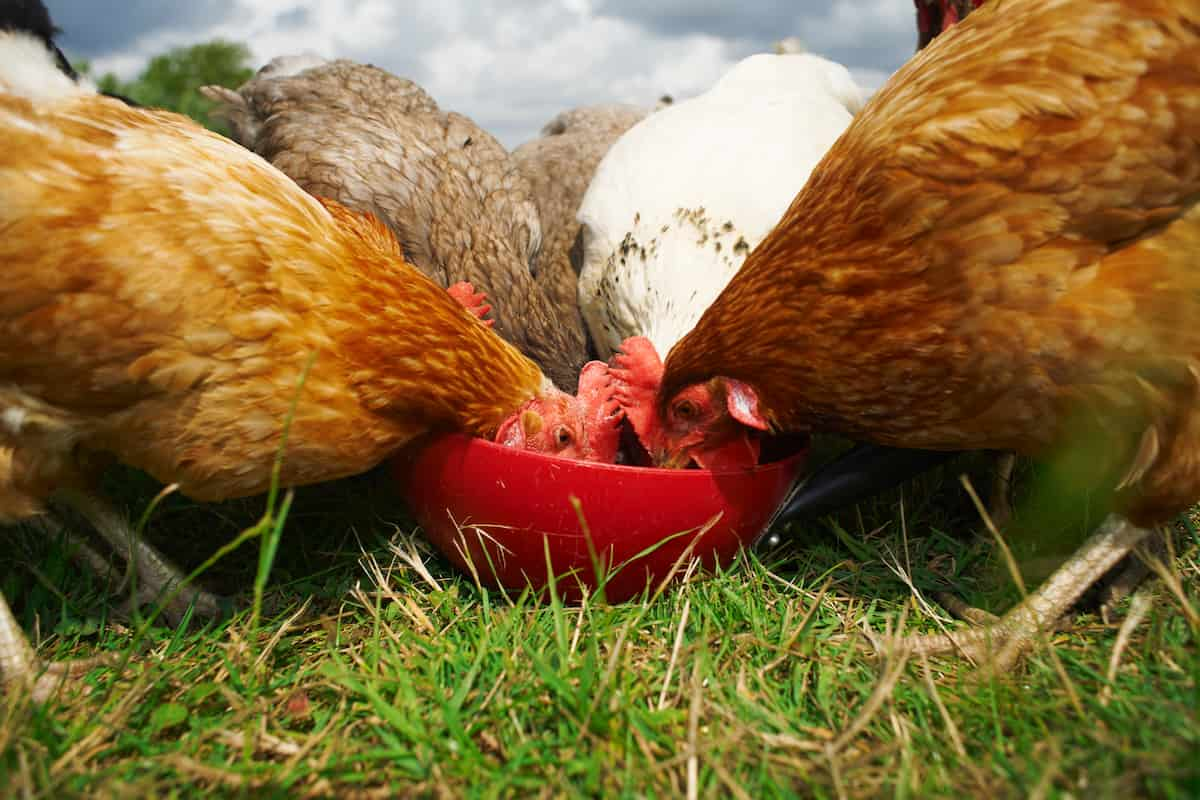In India, country chicken farming or desi hen farming has been practiced for decades. Local, indigenous birds are generally raised in backyard poultry. In the past, these birds had a poor egg and meat production capacity compared to commercial broiler and layer farms. Improved strains, however, result in significant performance improvements. Low initial investment and high economic returns are the biggest advantages of country chicken.

Feeding is one of the most important factors which decides the success rate of poultry farming. Faulty poultry feeding methods are directly responsible for the spread of many dangerous poultry diseases. Birds’ productivity is enhanced when they are fed a balanced diet. It keeps them healthy and prevents them from contracting various diseases. Consequently, understanding poultry feeding is essential to making poultry farming profitable.
Feed Management in Country Chicken
Ingredients in Country Chickens Feed
In poultry farming, poultry feed is of utmost importance. In the production of eggs and broilers, feed accounts for 80% of the costs. This mixture consists primarily of grains, de-oiled extractions of soybeans, rapeseeds, sunflowers, and calcium carbonates. When preparing a good feed, we must balance ME (Metabolism Energy), Protein, Calcium, Lysine, DL-Methionine, and others.
For poultry feed, the following ingredients are used: Maize, Bajra, Deoiled Rice Bran, Rice Polish, Jowar, Soybean Meal, Deoiled Ground Nut Extraction, Deoiled Sunflower, Deoiled Rapeseed, Fish Meal, Meat & Bone Meal, Shells, Marble Powder, Marble Chips.
Feed formulation in the poultry industry relies on a few key ingredients. In poultry diets, cereal grains are the main energy source, whereas grain legumes and oilseed cakes provide the main protein source. There are four main cereal grains: wheat, barley, triticale, sorghum, soybean meal, canola meal, peas, lupine, and beans. Historically, the industry has favored the cheapest ingredients to maximize profits.
Feed Textures
When grinding feed, knowing how long to crush and to what consistency is crucial. The term mash refers to the mash, crumble refers to the crumble, and pellets refer to the pellets. Depending on the age of your birds, you will need different textures.
- Mash: The first time chicks eat is similar to when a human baby eats. Their digestive system is getting started, and their beaks are too small for large items. Start the chicks with a mash when they are young. It has a similar consistency to potting soil. Feeding newborns until the age of eight to twelve weeks is important.
- Crumble: A crumble has a similar consistency to granola. The mixture has some larger chunks midway between the mash and pellets. By the 12-week mark, crumble is usually started until the chicken starts laying eggs. Introducing crumble to pellets before switching helps the chicken get used to the new texture.
- Pellets: Pellets are much larger and more difficult to digest than whole grains. It is best to reserve this food texture for chickens that are at least 18 weeks old.
How Much Quantity is to Be Fed to Country Chicken?
For the Baby Chickens of 0-2 Weeks
- The first feed should consist of finely broken rice, small grains, or breadcrumbs.
- Instead of plain water, skimmed milk or buttermilk should always be available for drinking.
- A week later, chick mash is introduced, which contains finely broken grains of rice, ragi, camber, wheat, or maize, supplemented with vitamins, minerals, antibiotic feed supplements, and coccidiostats.
In case you missed it: Feed Management in Ducks: Feeding Plan, Feed Formula, and Feed Requirement

From Two to Eight Weeks
- The quantity of chicken feed is gradually increased. Wet mashed potatoes and succulent, well-chopped greens like Lucern are introduced after six weeks.
- In addition to onions and garlic, some well-chopped garlic may also be added.
- Based on the chicken’s age (0-8 weeks), 10 to 50 grams of feed will be required per chicken.
After Eight Weeks
- Gradual substitution of chick mash with grower mash includes all essential nutrients for healthy growth at an economical price, enriched with vitamins and minerals. Amounts fed vary from 50 grams to 80 grams per grower per day, depending on their age (8-20 weeks).
- The 18th week is when a specially prepared layer of full vitamins and mineralized layer is introduced. A variety of well-chosen greens is also provided, as well as water.
- It is more economical and neat to feed pellets instead of mash. The bird is fed 80 to 200 grams daily, depending on its body weight and production capacity.
Proper Timing of Feeding the Chickens
As long as the birds are in good health, they will learn to expect to receive their feed on time. Up to eight weeks of age, baby chickens are fed five to six times a day in small amounts. In backyard units, the birds should preferably be let out early in the morning (just before sunrise) after being provided with clean water. A few days later, you can throw some grains out for the birds to pick, about 15 grams per bird.
Prior to noon, feed some greens, vegetable pruning, or kitchen trimmings, chopped well, and mixed with mash. In the evening, some more grains similar to those given in the morning can be fed. After a day of roaming, this will tempt all birds to return to their right shelter. Regularity is important for the birds to become accustomed to these timings.
Water Requirements for Country Chicken
There is no doubt that water is an essential nutrient, but it is often overlooked. Food is more important to animals than water to them. All aspects of an animal’s metabolism involve water. It regulates body temperature, digests food, and eliminates waste. A chicken consumes two times as much water as it consumes feed at normal temperatures.
The consumption of water can double or quadruple during periods of high temperatures. Poultry flocks need adequate quantities and quality water to remain healthy. The most important nutrient for birds is water, which must always be available.
Raise Country Chickens on Pasture
Raising your chickens on pasture (i.e., free-range) is an easy and inexpensive way to feed them and reduce their feed requirements. Chickens can self-regulate their diet provided they have enough pasture (e.g., a movable coop) or enough acreage. They can easily find enough insects, weeds, grasses, and seeds to remain healthy. Their diet will be more natural as a result.
In case you missed it: Feed Management in Layer Chickens: Feeding Plan, Feed Formula, and Feed Requirement

Providing supplemental feed to your chickens is a good idea, even if they are primarily foragers. Your chickens will need supplemental feed if you live in a region where the grass stops growing in the winter and food sources become scarce when temperatures plummet. In pastured birds, you cannot see what they’re eating all the time, which is one of their drawbacks. Among the hazards chickens eat are styrofoam, nails, screws, staples, peeling paint, and strings. Ensure your pasture area is safe for your birds by walking regularly and removing any potentially harmful items.
Conclusions
Feed efficiency determines the cost of a kilogram of poultry meat in poultry farming. Between 40 and 70% of the cost of production is attributed to feed, depending on the country and species. In determining a farm’s profitability, the Feed Conversion Ratio, which varies based on the type of production applied, is always a very useful benchmark. Knowing how to improve Feed Conversion Ratio and reduce feed costs is crucial for a poultry enterprise to increase revenue.
- Feed Your Flock for Less: Top 10 Tips to Save on Chicken Feed
- Ultimate Guide to Ossabaw Island Hog: Breeding, Raising, Diet, and Care
- Hatching Answers: The Top 10 Reasons Your Chickens Aren’t Laying Eggs
- Eggs and Economics: Breaking Down the Cost of Raising Backyard Chickens
- Defend Your Greens: Proven Methods to Keep Iguanas Out of Your Garden
- Ultimate Guide to Cinnamon Queen Chicken: A Comprehensive Guide for Beginners
- Ultimate Guide to California Tan Chicken: Breeding, Raising, Diet, Egg-Production and Care
- Ultimate Guide to Marsh Daisy Chicken: Breeding, Raising, Diet, and Care
- 10 Types of Chicken Farming Businesses You Can Start for Profits